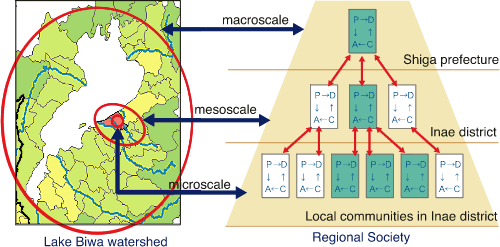Multi-Disciplinary Research for Understanding Interactions between Humans and Nature in the Lake Biwa-Yodo River Watershed
The differences in problem consciousness among various stakeholders occurring from “hierarchy” of a watershed could be a major hindrance to governance, leading to conflicts between top-down and bottom-up Management.
We proposed a system of “hierarchical watershed management” to overcome the restrictions derived from these hierarchical characteristics (Figure). Based on this idea, we conducted research on the agricultural turbidity problem in the Lake Biwa watershed to develop a methodology for environmental diagnosis and consensus building with an emphasis on communication. Our project is unique in 1) developing a new methodology to promote governance and participation of residents by 2) our transdisciplinary approach to natural science and social science 3) practiced in three scales in the Lake Biwa watershed (Shiga prefecture as macroscale, Inae district as mesoscale, local communities in Inae district as microscale, 4) moving towards practical watershed and global environmental studies.
Project Leader: Yachi Shigeo Center for Ecologocal Research, Kyoto University (RIHN until March 2008)
Specific Research Findings
(1) A new watershed diagnosis method revealing the relationship between Lake Biwa and its rivers
The results of newly developed watershed diagnosis methods including stable isotope ratios and rare elements indicate that agricultural activities related to smaller rivers flowing into the eastern part of the lake have a large potential impact on the water quality and eutrophication of Lake Biwa, and that fine-tuned water management and water channel cleaning by local residents through a bottom-up approach is both effective and necessary for the environmental preservation of Lake Biwa.
(2) Clarification of an integrated picture of the agricultural turbid water problem and establishment of a communication methodology to support local residents' voluntary environmental preservation activities
In the background of the agricultural drainage issue, lies a drastic change of Japan's agricultural policy and agricultural community structure, which caused an increase in part-time farmers and decrease in young farmers. A workshop method was developed to support residents themselves discussing the local water environment and its future prospects using maps. Practical workshops were held to confirm how the provision of information related to the current status of the water environment or measures for water environmental preservation would affect the farmers' awareness of environmental considerations or their actions. These results indicate the need to develop a communication method based on the assumption of the individuality of the community and the importance of conditions such as social capital that allow such a method to work effectively.
 | |
Figure Hierarchical Watershed Management System Applied to Lake Biwa Watershed in the Case of Agricultural Turbidity Problem | |
Contributions to Global Environmental Studies
There are two important issues that must be dealt with if we are to solve global environmental problems: (1) a watershed area is important in terms of scale. Dealing with it not only solves regional environmental problems but also constitutes a test bed for specific solutions to global environmental problems; and (2) It is essential to appropriately coordinate various stakeholders with various patterns of involvement in the environment that are deeply rooted in the area. Although this project has the methodology for watershed management as its main theme, we believe the project provided a prototype methodology which can contribute to the way we consider and solve global environmental problems.
Communication of Research Findings
The project final report (in Japanese, ISBN 978-4-902325-11-9) is now available at University libraries in Japan and at the libraries of cities and towns in the Shiga prefecture. In it, 5-year transdisciplinary research on watershed management is compiled as a first step to “watershed environmental studies” with close connection to global environmental problems. Readers will find not only the new research findings but also the message and dynamism of the project emphasizing the importance of practice in regional societies, the social meaning of transdisciplinary collaboration, d academic and social issues to be challenged.

